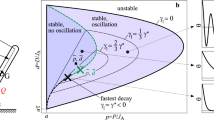Abstract
A key finding of human balance experiments has been that the integration of sensory information utilized for postural control appears to be dynamically regulated to adapt to changing environmental conditions and the available sensory information, a process referred to as “sensory re-weighting.” We propose a postural control model that includes automatic sensory re-weighting. This model is an adaptation of a previously reported model of sensory feedback that included manual sensory re-weighting. The new model achieves sensory re-weighting that is physiologically plausible and readily implemented. Model simulations are compared to previously reported experimental results to demonstrate the automated sensory re-weighting strategy of the modified model. On the whole, the postural sway time series generated by the model with automatic sensory re-weighting show good agreement with experimental data, and are capable of producing patterns similar to those observed experimentally.





Similar content being viewed by others
References
Carver S, Kiemel T, Van der Kooij H, Jeka JJ (2006) Comparing internal models of the dynamics of the visual environment. Biol Cybern 92:147–163
Cenciarini M, Peterka RJ (2006) Stimulus-dependent changes in the vestibular contribution to human postural control. J Neurophysiol 95:2733–2750
Cohen L (1995) Time–frequency analysis. Prentice-Hall, New York
Day BL, Severac Cauquil A, Bartolomei L, Pastor MA, Lyon IN (1997) Human body-segment tilts induced by galvanic stimulation: a vestibularly driven balance protection mechanism. J Physiol 500:661–672
Fitzpatrick R, Burke D, Gandevia SC (1996) Loop gain of reflexes controlling human standing measured with the use of postural and vestibular disturbances. J Neurophysiol 76:3994–4008
Fujisawa N, Masuda T, Inaoka H, Fukuoka Y, Ishida A, Minamitani H (2005) Human standing posture control system depending on adopted strategies. Med Biol Eng Comput 43:107–114
Horak FB, Macpherson JM (1996) Postural orientation and equilibrium. In: Rowell LB, Shepherd JT (eds) Handbook of physiology: section 12: exercise: regulation and integration of multiple systems. Oxford University Press, New York, pp 255–292
Ishida A, Masuda T, Inaoka H, Fukuoka Y (2008) Stability of the human upright stance depending on the frequency of external disturbances. Med Biol Eng Comput 46(3):213–221
Jeka J, Allison L, Saffer M, Zhang Y, Carver S, Kiemel T (2006) Sensory reweighting with translational and visual stimuli in young and elderly adults: the role of state-dependent noise. Exp Brain Res 174:517–527
Johansson R, Magnusson M (1991) Human postural dynamics. Crit Rev Biomed Eng 18:413–437
Kiemel T, Oie KS, Jeka JJ (2002) Multisensory fusion and the stochastic structure of postural sway. Biol Cybern 87(4):262–277
Kuo AD (1995) An optimal control model for analyzing human postural balance. IEEE T Bio-Med Eng 42:87–101
Loram ID, Maganaris CN, Lakie M (2007) The passive, human calf muscles in relation to standing: the non-linear decrease from short range to long range stiffness. J Physiol 584:661–675
Loughlin PJ, Pitton J, Atlas L (1994) Construction of positive time–frequency distributions. IEEE T Signal Process 42:2697–2705
Mahboobin A, Loughlin P, Redfern MS, Sparto PJ (2005) Sensory re-weighting in human postural control during moving-scene perturbations. Exp Brain Res 167(2):260–267
Maki BE (1986) Selection of perturbation parameters for identification of the posture control system. Med Biol Eng Comput 24:561–568
Maurer C, Mergner T, Peterka RJ (2006) Multisensory control of human upright stance. Exp Brain Res 171(2):231–250
Mergner T, Maurer C, Peterka RJ (2003) A multisensory posture control model of human upright stance. Prog Brain Res 142:189–201
Morasso PG, Baratto L, Capra R, Spada G (1999) Internal models in the control of posture. Neural Netw 12:1173–1180
Nashner LM (1982) Adaptation of human movement to altered environments. Trends Neurosci 5:358–361
Peterka RJ, Benolken MS (1995) Role of somatosensory and vestibular cues in attenuating visually induced human postural sway. Exp Brain Res 105:101–110
Peterka RJ (2002) Sensorimotor integration in human postural control. J Neurophysiol 88:1097–1118
Peterka RJ (2003) Simplifying the complexities of maintaining balance. IEEE Eng Med Biol 22(2):63–68
Peterka RJ, Loughlin PJ (2004) Dynamic regulation of sensorimotor integration in human postural control. J Neurophysiol 91:410–423
Van der Kooij H, Jacobs R, Koopman B, Grootenboer H (1999) A multisensory integration model of human stance control. Biol Cybern 80:299–308
Van der Kooij H, Jacobs R, Koopman B, Van der Helm F (2001) An adaptive model of sensory integration in dynamic environment applied to human stance control. Biol Cybern 84:103–115
Acknowledgments
The research of P. Loughlin, A. Mahboobin and M. Redfern was supported by the National Institutes of Health [R01 AG029546 (NIA)], and the Pittsburgh Claude D. Pepper Older Americans Independence Center [P30 AG024827 (NIA)]. The research of C. Atkeson was supported in part by the National Science Foundation under grants ECS-0325383 and EEC-0540865.
Author information
Authors and Affiliations
Corresponding author
Appendix: Sensory difference threshold determination
Appendix: Sensory difference threshold determination
To determine the threshold εSD (see Sect. 2.2), consider a Gaussian noise process \(x {\sim}N(0,\sigma^{2})\). We would like to find the probability that 1−P(−εSD ≤ x ≤ εSD) < ζ, where ζ is a small number and εSD is the desired sensory difference threshold. Solving for εSD results in
where erf is the error function.
In our model simulations, we take the noise variance, i.e., σ2, as the sum of the sensory channel noise variances, σ2 = σ 2p + σ 2g , with proprioceptive and graviceptive channel noise variances (post-filtering) set to 0.002 deg2 and 0.0215 deg2, respectively. With these values, and ζ = 1 × 10−3, Eq. 7 yields εSD ≥ 0.50°. We therefore took εSD = 0.50°.
Rights and permissions
About this article
Cite this article
Mahboobin, A., Loughlin, P., Atkeson, C. et al. A mechanism for sensory re-weighting in postural control. Med Biol Eng Comput 47, 921–929 (2009). https://doi.org/10.1007/s11517-009-0477-5
Received:
Accepted:
Published:
Issue Date:
DOI: https://doi.org/10.1007/s11517-009-0477-5




